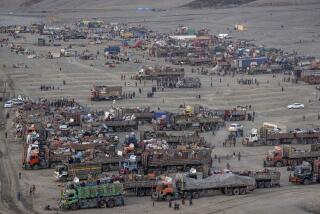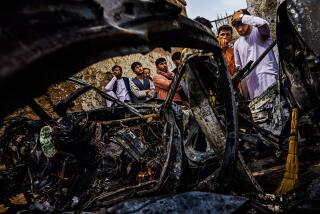More Swat Valley refugees return home
Reporting from Nowshera, Pakistan — They loaded their dirt-caked tents, clothes, bed frames and sacks of flour onto trucks early Monday and then piled into buses, desperate to leave the sweltering camps in northwestern Pakistan where they had lived for more than two months -- but unsure what awaited them in their war-ravaged hometowns.
Monday marked the first day of a government program meant to return residents to the Swat Valley and surrounding districts after a two-month assault that Pakistani officials say succeeded in routing Taliban militants there. But as people readied themselves for the trip home, many said they worried that insurgents had simply fled when Pakistani troops rolled in, and could return to their villages to reassert their often brutal rule.
“We’re not happy about going back,” said Yaqoob Shah, 21, a laborer who, along with his parents and four brothers, fled their village of Thana and sought refuge at the sprawling Jalozai camp here in the town of Nowshera.
“The fighting is still going on there, but the government is forcing us to go,” Shah said. “Yesterday there was a bomb blast in our village that killed nine security personnel. And there aren’t any jobs there. There’s nothing to go back to.”
The firepower that militants in Pakistan wield was underscored by a powerful blast Monday that killed nine people, at least seven of them children, injured 70 others and razed dozens of homes in the central Punjab village of Mian Channu. Police said the explosion occurred at a home and madrasa owned by a man who allegedly belonged to a banned Pakistani extremist group.
The cause of the blast has yet to be determined, but police said they found an explosives vest, rocket launchers and other weapons in the rubble of Riaz Ali’s building. Ali was in critical condition at a local hospital. Authorities said the explosion was not the result of a suicide attack.
The Pakistani government hailed Monday as a landmark in its ongoing quest to permanently rid the country of Taliban militancy.
Authorities assert that they have retaken control of Swat after killing more than 1,600 militants in an all-out offensive that began in late April. President Asif Ali Zardari’s government sent fighter jets, helicopter gunships and troops into Swat after the Taliban reneged on a peace deal this spring and expanded its reach to within 60 miles of the capital, Islamabad.
Defense analysts have warned that although militants have been driven out of Swat’s major towns, pockets of fighters and many Taliban commanders remain holed up in the densely forested ridges that course through the picturesque valley, once a mecca for Pakistani tourists.
Military leaders insist, however, that Swat and the nearby districts of Dir and Buner are now completely secured, and that residents can begin to return. More than 2 million Pakistanis were displaced by the fighting. Most sought refuge in the homes of relatives or friends outside the conflict zone, but as many as 200,000 ended up in tent camps.
Refugees will be returning in phases, with those living in camps going back first, followed by people who had been living with relatives. The process is expected to take at least two weeks. Before they leave, refugees are being given one month’s ration of flour, sugar, vegetable oil and beans, along with a $300 stipend.
Authorities say they have restored electricity, clean drinking water, telephone and healthcare services in Swat’s towns and villages.
Police have begun to return as well, and Pakistani troops will remain in Swat to ensure Taliban militants do not resurface, government officials said.
International aid groups say the volatile security environment in Swat makes it difficult to carry out independent assessments of conditions there for returning refugees.
John Holmes, the United Nations’ emergency relief coordinator, said last week that he and his team went to the Buner district to check on the situation, but had been unable to visit Swat “because of the current security situation there in recent weeks.”
“It’s crucial that the process . . . is properly voluntary, that the conditions are there, that people are not being pushed back before they’re ready,” Holmes added.
“People will tend to know for themselves when conditions are right.”
At the Jalozai camp, residents reacted with a mix of glee and anxiety at the prospect of returning to Swat.
Peering from the window of a bus filled with fellow Swat residents, Mohammed Asif, 19, beamed as he watched the caravan slowly drive from a camp, where they lived in tents, baked in triple-digit heat, for two months.
Heading back to his home in Barikot, he said he and his family had no prospects for jobs and very little money in their pockets. Still, the bleak outlook didn’t dampen Asif’s mood.
“We are so very happy to go back,” Asif said, shouting to make himself heard over the din of bus horns.
“We have been praying for this day. We’ve been told the security situation there is good, so we’re going back.”
Others weren’t as optimistic. Bakht Anwar, 31, assembled his wife, father, two daughters and four sons alongside the line of buses and trucks, but only because he knew the government would no longer provide food if they stayed.
Cradling a 4-year-old son who couldn’t stop coughing, Anwar said the withering heat and dust at Jalozai made life unbearable for his children. But he worried that they were returning to a hometown still beset by violence.
“For me, it’s still very scary there,” said Anwar, a laborer at a local school in Barikot. “The reasons why we left Swat, I think they are still there.
“But we have no choice but to do what the government orders. If we stay, we won’t get any more food.”
More to Read
Sign up for Essential California
The most important California stories and recommendations in your inbox every morning.
You may occasionally receive promotional content from the Los Angeles Times.










